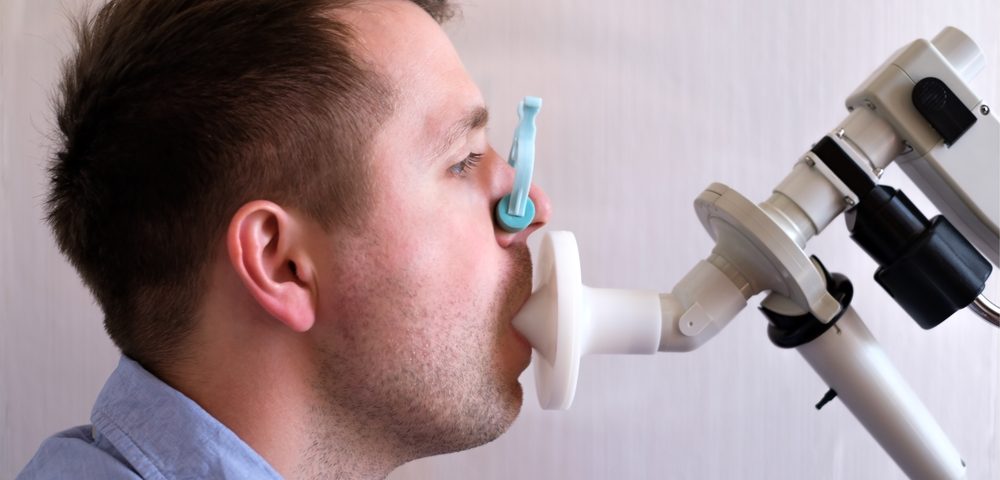Dealing with My Pulmonary Function Tests

As a kid, there were two things I really couldn’t stand: math and pulmonary function tests (PFTs). I was too young and naive to have an angry fanboy mentality toward the “Star Wars” prequels. Math, however, didn’t coincide with my interests or adolescent attention span, and by the time I was in middle school, it went from being my least favorite subject in school to my greatest enemy. PFTs, while being something I had to deal with much less frequently, were still a form of torture in my mind.
PFTs have changed somewhat since the time I started doing them. The first test requires me to take deep breaths in and out through my mouth. The pulmonology assistant who does the tests will either hold my nose or put a pin on it to make sure I can’t breathe through it. Sounds fun, right?
Once the machine is on and there’s a tube in my mouth, the assistant tells me to inhale and exhale large amounts of air. While it’s pretty standard for any doctor to monitor a patient’s breathing, the whole stethoscope and deep breath routine is kid’s stuff compared to PFTs.
One of the tests I used to have to do, that they’ve since gotten rid of, was the “puppy dog breath” test. This involved taking as many rapid breaths as I could for about 30 seconds, which I guess made me sound like a puppy anxiously waiting for a treat. A computer screen in front of me tracked my activity. A horizontal line that moved up and down across the screen would indicate how fast and steady my breaths were.
I hated that one in particular, and I felt exhausted every time I did it. It didn’t help that the assistant I had when I was younger reminded me of the mean lady in “Matilda.” OK, she wasn’t that bad, but she wasn’t pleasant, either. I didn’t need another reason to dread doing these stupid tests every few months.
The assistants who do my PFTs now are incredibly nice and pleasant people, by the way.
For a long time, the only thing that got me through PFTs and pulmonology appointments were: my mom buying me lunch on the way home, and getting to either leave school early or have the day off. In college, I could schedule doctor’s visits around my class schedule so that I wouldn’t miss anything, but in grade school, I could at least miss a few classes for a weekday appointment.
PFTs frustrated me as a kid for several reasons. I mentioned that they wiped my energy, but beyond that, I didn’t understand the point in doing them. I knew my respiratory levels sucked back then, and PFTs just reinforced that notion for me. They were like tests I knew I couldn’t pass, so why bother? Plus, I had to listen to the “Matilda” lady bark orders at me and tell me to try harder.
Over time, however, I did get used to PFTs as just another component of my care routine. I was accustomed to the structure of these tests by the time I was a teenager, but beyond that, I was actually showing signs of improvement in my respiratory functions. Even before I started Spinraza (nusinersen), I was using devices like my Vest Airway Clearance System and cough assist machine to combat respiratory issues and improve my levels. Once I got past the notion that SMA made it impossible for me to have good respiratory function, I became more relaxed about the tests.
Today, I still don’t enjoy doing PFTs, but I no longer dread them. They’re irritating and they wear me out, but I find comfort knowing that my respiratory levels are no longer abnormally low. It’s taken a lot of discipline for me to use my BiPAP, vest, and cough assist, and to do my PFTs regularly, but all of those tubes and machines have proven to be worth the time and effort.
Plus, my mom still lets me stop for lunch on the way home from my pulmonologist appointments.
Do you dread doing PFTs? Join in the discussion in our forums.
***
Note: SMA News Today is strictly a news and information website about the disease. It does not provide medical advice, diagnosis, or treatment. This content is not intended to be a substitute for professional medical advice, diagnosis, or treatment. Always seek the advice of your physician or other qualified health provider with any questions you may have regarding a medical condition. Never disregard professional medical advice or delay in seeking it because of something you have read on this website. The opinions expressed in this column are not those of SMA News Today, or its parent company, Bionews Services, and are intended to spark discussion about issues pertaining to spinal muscular atrophy.









David Norriss
I like how you explained how the pulmonary function tests over the years actually helped you raise your respiratory levels and that they were worth it. My son has respiratory problems and his doctor told him that he'll most likely need to do a pulmonary test on him. I'll share your story with my son and hopefully, it will give him comfort to know that his problems will go away with time too.